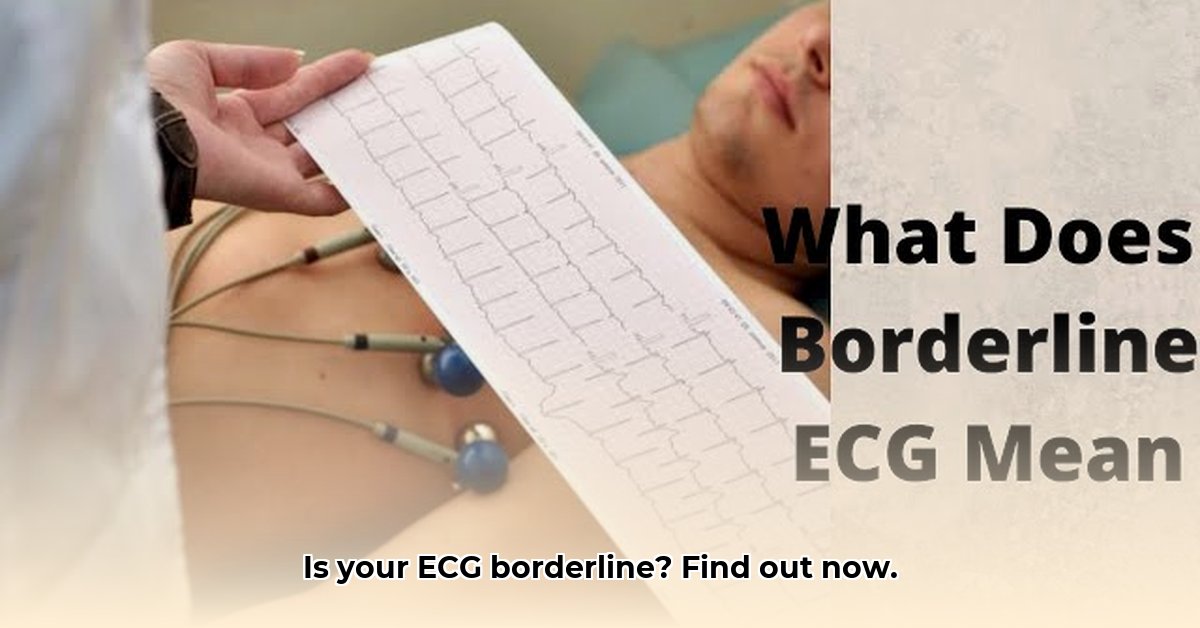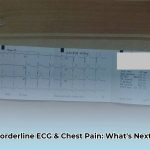Received a borderline ECG result and feeling uncertain? It’s completely understandable – that “borderline” designation can create anxiety. Perhaps you’re experiencing occasional chest discomfort or noticing slight irregularities in your heartbeat. This guide is designed to provide clarity on what a borderline ECG signifies, what it doesn’t necessarily mean, and the recommended steps you should take. We’ll demystify the medical terminology, help you interpret your ECG report, and equip you with the knowledge to feel more confident about managing your heart health. We’ll also explore the recommendations of cardiologists for both short-term management and long-term planning. Let’s empower you with the information you need to proactively care for your heart.
Deciphering Borderline ECG Symptoms
So, you’ve been informed that you have a borderline ECG result. This news can understandably cause concern. It indicates that your electrocardiogram – the test that records your heart’s electrical activity – revealed some deviations from the norm, but not to the extent that a definitive diagnosis can be made. Think of it this way: the electrical rhythm of your heart appears somewhat “unclear” on the tracing, lacking the sharp definition of a perfectly normal reading. While it doesn’t automatically point to a serious health issue, it does warrant further investigation. Let’s clarify the situation through a detailed examination of symptom identification.
Defining a Borderline ECG
A borderline ECG essentially means that your heart’s electrical signals deviate slightly from the ideal. These are minor variations from what is considered a completely normal heart rhythm, but they aren’t significant enough for a physician to confidently diagnose a specific heart condition. It exists within a grey area of cardiac health, raising questions that require more in-depth assessment to answer than providing immediate solutions. Interpretation heavily depends on individual factors and the inherent diagnostic uncertainty.
Recognizing Potential Indicators: Do You Have Borderline ECG Symptoms?
Many individuals with these somewhat atypical ECG results feel perfectly healthy and don’t report any noticeable symptoms. However, others may experience subtle changes in their physical well-being. These potential indicators merit careful consideration and patient experiences.
- Heart Palpitations: The sensation of your heart racing, fluttering, pounding, or skipping beats. These episodes might be infrequent and unpredictable.
- Breathing Difficulties: Experiencing a slight shortness of breath, particularly during physical activity, without any obvious underlying cause.
- Persistent Fatigue: Feeling unusually tired or exhausted, even after adequate sleep. This ongoing fatigue could be a subtle indication.
- Chest Discomfort: A mild sensation of tightness, pressure, or aching in the chest, distinct from the intense, crushing pain associated with heart attacks. This discomfort is typically mild and transient.
- Dizziness or Lightheadedness: Feeling faint, unsteady, or as though you might lose consciousness.
Important Reminder: Even if you feel well and don’t exhibit any of these symptoms, a borderline ECG necessitates follow-up. The test provides an initial assessment but isn’t conclusive. It serves as a starting point for further evaluation and actionable steps.
The Necessity of Further Testing
An ECG captures a single moment of your heart’s electrical activity. A borderline result indicates an area that demands a more thorough evaluation. It does not offer a complete overview of your heart’s health. Several factors can influence the outcome. Let’s examine the reasons why further testing is essential and diagnostic procedures.
Recommended Next Steps from Your Doctor
Your doctor will evaluate various elements when recommending additional tests. These include your age, family history of heart disease, pre-existing medical conditions, lifestyle choices, and, of course, any symptoms you’ve reported. Based on this comprehensive assessment, they may suggest one or more of the following tests, with a strong emphasis on patient care.
-
Repeat ECG: A repeat ECG can sometimes determine whether the initial borderline result resulted from temporary factors, such as anxiety or unintentional movement during the initial test. This provides a simple way to assess whether the result was an anomaly.
-
Holter Monitor: This small, portable device is worn for 24 to 48 hours. It continuously records your heart’s rhythm, offering a more extended and comprehensive view of its activity. This is especially helpful in detecting intermittent arrhythmias that might not appear on a standard ECG.
-
Cardiac Stress Test: You’ll engage in physical activity on a treadmill or stationary bike while your heart activity is closely monitored. The test reveals how your heart performs under stress, giving your doctor valuable insights into its function.
-
Echocardiogram (Echo): This ultrasound of your heart generates detailed images of its structure and assesses how effectively it’s pumping blood. It’s a non-invasive technique for visualizing the heart.
-
Blood Analysis: Specific blood tests can assist in ruling out other medical conditions that might impact the health of your heart. These tests can check for things like electrolyte imbalances, thyroid problems, or signs of inflammation.
Lifestyle Adjustments: Enhancing Your Heart Health
While awaiting the results of further tests, prioritizing heart-healthy habits is recommended. Making positive lifestyle change reduces strain on your heart and improves overall well-being, irrespective of the ECG results with preventative measures. Here’s how:
| Lifestyle Factor | Recommendation | Benefits |
|---|---|---|
| Consistent Physical Activity | Aim for a minimum of 150 minutes of moderate-intensity aerobic activity or 75 minutes of vigorous-intensity activity per week. | Enhances cardiac function, strengthens the heart muscle, aids in weight management, and reduces the risk of heart disease. |
| Nutritious Eating Habits | Prioritize fruits, vegetables, whole grains, and lean proteins. Limit processed foods, sugary beverages, and saturated fats. | Supplies essential nutrients, helps maintain a healthy weight, reduces strain on the heart, and lowers cholesterol levels. |
| Effective Stress Reduction | Adopt relaxation methods like meditation and yoga or practice deep breathing exercises. | Reduces blood pressure, minimizes the risk of heart complications, and promotes emotional well-being. |
| Smoking Cessation | Quitting smoking is essential, as it’s a significant risk factor for heart disease. | Significantly lowers your risk of heart disease, lung cancer, and other serious health problems. |
| Maintain Healthy Weight | Even modest weight loss can greatly benefit your heart’s health. | Reduces stress on your heart, improves overall physical condition, and lowers the risk of diabetes and high blood pressure. |
| Adequate Sleep | Aim for 7-9 hours of quality sleep each night. | Improves heart health, regulates blood pressure, and enhances overall well-being. |
Keep in mind that a borderline ECG isn’t a diagnosis, but rather an indication that further evaluation is necessary to safeguard your heart’s long-term well-being. Maintaining open communication with your physician, adhering to recommended testing, and adopting heart-healthy lifestyle choices are vital to understanding your specific situation and protecting your heart’s health. Don’t hesitate to voice any concerns or questions you may have with your doctor. You have the right to fully understand your health status, promoting patient empowerment.
Interpreting Borderline ECG Results with Atypical Symptoms
Key Considerations:
- A borderline ECG is not definitive; it’s neither clearly normal nor clearly abnormal.
- Further testing is essential to rule out any underlying heart issues.
- Your symptoms are crucial for accurate interpretation. Atypical symptoms add complexity to the diagnostic process.
- Comprehending your results necessitates collaboration with your doctor and a comprehensive understanding of diagnosis challenges.
Understanding Borderline ECG Results
Receiving a “borderline” ECG result can create uncertainty. It implies that your electrocardiogram – the test that evaluates your heart’s electrical activity – displays some irregularities, but not enough to establish a definite diagnosis. Consider it a somewhat blurred image; something appears unusual, but a sharper picture is needed for accurate identification. This ambiguity underscores the importance of additional evaluation.
Significance of Atypical Symptoms
The presence or absence of symptoms significantly affects how to interpret borderline ECG results with atypical symptoms. Atypical symptoms are those that don’t typically align with conventional heart problems, making diagnosis more challenging. For instance, fatigue can indicate heart issues, but it’s also linked to numerous other conditions. Chest pain, however, is more consistently associated with heart problems. Your doctor requires this comprehensive information to effectively assess your condition, emphasizing symptom analysis. Common atypical symptoms may include:
- Unexplained fatigue
- Jaw pain
- Back pain
- Nausea
- Shortness of breath without chest pain
Subsequent Steps
Your cardiologist will likely recommend further examination to clarify the borderline ECG findings. These might include and cardiological assessment:
- Echocardiography: Employs sound waves to produce images of your heart’s structure and its function.
- Exercise Stress Test: Evaluates your heart’s response to physical exertion.
- Holter Monitoring: A portable ECG device worn for 24 hours or longer, continuously recording your heart’s rhythm.
- Blood Tests: Conducted to assess electrolyte balance and check for other factors affecting heart function.
The specific tests recommended are determined by various factors, including your symptoms, medical history, and the specific irregularities observed on the initial ECG.
- How Much Do Wellness Programs Cost Businesses To Offer? - December 16, 2025
- Wellness Fair Ideas for Work to Boost Employee Wellbeing - December 15, 2025
- Affordable Employee Wellness Fair Ideas for Any Budget - December 14, 2025
















